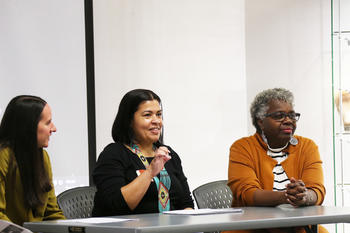
Jacob Bledsoe found a passion project amongst the Native American artifacts in his college’s art collection.
Many pieces include personal items like clothing donated by a former teacher at the Carlisle Indian School.
Some were taken, and others were given by Indian students enrolled at the school in the early 1900s.
An archaeology student at Berea College in Kentucky, Bledsoe is working to identify which tribes the Carlisle students came to the school from, hoping to one day return the artifacts to their true homes. Bledsoe's research resonates strongly with the local community, said Dr. Mary Ann Jacobs, chair of the UNCP American Indian Studies Department. After all, at least 10 Carlisle students from the time the artifacts were collected were identified as Lumbee.
Bledsoe made the eight-hour trip from Berea to UNC Pembroke last week to present his research at the 19th annual Southeast Native Studies Conference.
"They gave me some great feedback and were supportive," Bledsoe said. "Especially for someone coming from so far away to present research that wasn’t regionally focused.”
During the two-day conference, Virginia Tech doctoral student Marie-lys Chambraud shared her studies of the Eastern Band of Cherokee code talkers of World War I, whose success inspired the better-known use of Navajo code talkers during World War II.
Dr. Seth Grooms, an assistant professor in the Department of Anthropology at Appalachian State University and a member of the Lumbee Tribe, spoke about future plans for the Lumbee River Community Archaeology Project.
And UNCP alumnus Kevin Melvin gave a moving, first-hand account of the Life by the River project he led, culminating in creating an 18-foot-long, 1,500-pound dugout canoe. The canoe, named Wisdom, was created using the burnout method American Indians used hundreds of years ago. Plans are for the canoe to be permanently displayed at the Museum of the Southeast American Indian. Melvin's voice cracked with emotion when speaking about his inspiration for the eight-month-long project.
“When my great-grandkids are older and see this canoe, I want them to be proud to know that this is something their grandfather made,” said Melvin, who earned a degree in American Indian Studies in 2015.
The conference also provided a forum for UNCP undergraduate scholars Unmai Arokiasamy and Ahelayus Oxouzidis to discuss their community-driven oral history project capturing the stories and memories of Lumbee elders through interviews.
“We are conglomerating our oral history and building our archive,” Arokiasamy said. “A lot of the knowledge being passed about Lumbee people got disrupted during the Colonial period, so there were misrepresentations by Colonial perceptions of Native people. But this new archive is voiced by Lumbee people and will be housed by Lumbee people.”
Afterward, Dr. Jacobs stressed the significance of the conference and why discussions of the culture, history, art and contemporary issues of American Indians in the Southeast must continue. It is perhaps the only conference in the country dedicated solely to the history and cultures of southeastern Indigenous peoples.
“The overall goal has always been to encourage people to continue to document the fact that the Southeastern portion of the United States was and is Indigenous,” Jacobs said. “No other conference in the nation is saying the Southeast is important enough and that an entire conference needs to be dedicated to that—but we are.
“It’s important to understand that this whole country was Indigenous, and Indigenous people are still here and we are an important part of the Indigenous Studies literature and American history.”